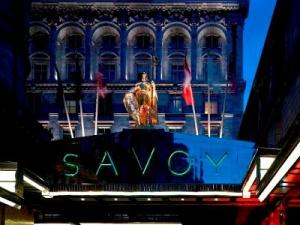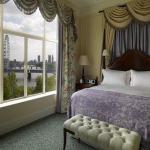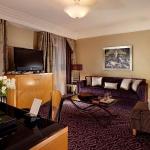
by editor | Dec 18, 2011 | Lifestyle

The Savoy Hotel London
The hotel is situated just off the Strand five minutes from Charing Cross mainline and underground station and in the heart of London’s bustling West End, Theatre-land, Trafalgar Square, Covent Garden and some of London’s best shopping areas are all nearby. The rear of the hotel overlooks the Thames.

A British icon since 1889, The Savoy has once again taken its place on the world stage after over a £100 million restoration. The hotel seamlessly blends elements of the original and the new while the stunning English Edwardian and Art Deco interiors sparkle with timeless elegance and glamour.
The Savoy hotel is an imposing cream coloured building with a very grand entrance set back from the Strand, in the heart of London. The lobby is very large and is elegantly furnished and decorated with the use of elegant marbles and dark wood. A large and comfortable seating area lies in front of the large reception desk. An elegant staircase leads on to the bar area where clients can enjoy a snack and a great english afternoon tea. The Savoy continues to live up to its reputation as a bastion of English exclusivity.
The 268 guestrooms and suites are the last word in style, luxury and discreet technology with stunning views of London and the River Thames. The rooms are decorated in pale colours, they are light and airy, with sixty rooms commanding magnificent views over the river thames. The well-appointed marble bathrooms all feature separate walk-in showers with the famous Savoy rain showerheads and are finished with large chrome fittings and Miller Harris amenities. Nine ‘signature suites’ have been styled after nine of The Savoy’s most high profile guests while a newly created 2-bedroom Royal Suite is truly a suite fit for a King.
As would be expected from a hotel whose first chef was the legendary Auguste Escoffier, The Savoy’s selection of restaurants is legendary. The inspired cuisine of chef/patron Marcus Wareing can be enjoyed in the Michelin starred Savoy Grill and the more informal Banquette. Legendary bartender Harry Craddock’s classic cocktails are still served in the newly renovated American Bar and the new Beaufort Bar offers one of the finest selections of Champagne in the city. The Savoy has also played host to many historic events and the restored Banqueting and Private Rooms will once again see the great and the good return to The Savoy.
From palatial meeting rooms to the facilities in the Fitness Gallery, The Savoy is truly an exceptional hotel.

Savoy Hotel Gallery:
















by editor | Dec 18, 2011 | Lifestyle

 The Savoy Hotel
The Savoy Hotel
Multi-Million Pound Investment
15 May 07
Restoration of The Savoy will re position it amidst finest hotels in the world
Fairmont Hotels & Resorts today announced that The Savoy, one of Britain’s most internationally recognised hotels, will benefit from a programme of restoration that will include upgrading of the magnificent suites overlooking the Thames, renovation of guest rooms, corridors and all public areas and the reopening of the renowned River Restaurant. The estimated cost of the program, in excess of one hundred million sterling, makes the restoration of The Savoy, on a per room basis, one of the most ambitious in the history of London. The proposed date when the hotel will cease taking guest reservations is currently set at December 2007 when the restoration process is scheduled to begin. The Savoy is projected to reopen in 2009.
According to Kiaran MacDonald, General Manager of The Savoy, extensive planning has gone in to The Savoy project. For us, the most important thing was to honour the art deco heritage and traditional English design of the hotel, while upgrading the property to meet the expectations of today’s most discerning guests. When The Savoy reopens we hope to set new British standards for excellence in design, d’cor and personalised service.
The period when the hotel will not be open for guests is currently anticipated at approximately sixteen months. It was a difficult decision to cease taking reservations at the hotel, but we could not envisage disrupting our guests on a daily basis, said MacDonald. A project of this scope could take much longer if the hotel was left open and we wish to stick to a rigorous schedule in order to reopen as quickly as possible. We are confident that our loyal guests, many of whom have a strong attachment to the hotel, will be pleased with the results.
Fairmont Hotels & Resorts, a company, which currently owns and manages some of the most historic hotels in the world, has chosen designer Pierre-Yves Rochon for The Savoy project. Rochon was chosen for his creativity and proven expertise with luxury hotels throughout North and South America, Asia, the Middle East and Europe.
Throughout the period of the closure, The Savoy will remain in regular contact with valued guests, event organisers and travel intermediaries regarding the progress on the restoration programme.
Until December, 2007, The Savoy will continue to operate as usual.
For further information please contact 44 (0) 20 7836 4343 and ask for reservations.

by editor | Dec 6, 2011 | Health

 What Every Woman Should Know
What Every Woman Should Know
about Breast Cancer,
Compiled by Those in the Know…(NHS Choices)
Kylie, Sheryl Crow, Cynthia Nixon star of Sex in the City and now the fictional character Sally from Coronation Street, what do all these women have in common? They have all faced real or portrayed public battles with breast cancer, highlighting one of the most common of the female cancers.
There are around 46,000 cases diagnosed every year in England and Wales. With 1 in 9 women affected by breast cancer during their lifetime, the likelihood of someone you know being affected is significant. With early detection there is a good chance of recovery and it is vital that women check their breasts regularly for any changes and always get any changes examined by their GP.
Many people experience feelings of helplessness, isolation and disbelief when first given the diagnosis of cancer and may want to retreat from and ignore the situation. However, once the initial shock wears off, many often galvanise themselves and start to prepare their bodies for battle with military precision. A major part of that strategy involves researching the condition and improving an often-rudimentary knowledge of the disease and its effects.
Around 1.6 million women receive NHS breast screening a year. If you are diagnosed with breast cancer, knowing the questions to ask can help you to understand more about your condition and the treatment.
What should you know once diagnosed?
- At what stage is your cancer?
- When can you expect to start treatment and what side effects might you experience?
- What is the treatment going to achieve? Is it likely to cure the cancer or will it slow down the growth of the cancer and improve symptoms?
- Is there’s someone at the hospital you can contact if you feel unwell, before or after the treatment and do you need to contact your GP?
- There are often practical issues that need to be sorted out (transport or financial matters, for example). Ask if there’s someone at the hospital who can advise you about things such as benefits.
- Jot down questions as they occur to you and take these with you when you see your doctor, consultant and nurse.
NHS Choices has a comprehensive guide to breast cancer, all in one place at www.nhs.uk Aimed at everyone ranging from those interested in lifestyle changes that could decrease the chances of developing breast cancer, to the newly diagnosed and the war weary, who have battled with the illness for a long time and are after inspiring stories from other sufferers.
For more information about breast cancer symptoms, causes and treatments to prevention & screening articles, visit www.nhs.uk

by editor | Dec 5, 2011 | Health

 “Black and minority ethnic people have contributed greatly to the NHS for over 60 years since the Windrush era, this recognition by NHS Choices shows the appreciation to all those inspirational health heroes throughout the UK.”
“Black and minority ethnic people have contributed greatly to the NHS for over 60 years since the Windrush era, this recognition by NHS Choices shows the appreciation to all those inspirational health heroes throughout the UK.”
As the UK enters Black History month, the national website of the NHS is putting the spotlight on black health heroes through its dedicated site www.nhs.uk/blackhistorymonth. The site profiles individuals from within the African and Caribbean community that are improving the health and lives of others. The site also provides information on conditions that have greater prevalence amongst the black population.
“Black and minority ethnic people have contributed greatly to the NHS for over 60 years since the Windrush era, this recognition by NHS Choices shows the appreciation to all those inspirational health heroes throughout the UK.”
The health heroes celebrated include Dr Tunji Lasoye an A&E consultant and surgeon in an inner city hospital. Rudolph Isaacs, a rare-type blood donor whose donations are especially vital to people who suffer with sickle cell anaemia, and the nursing trailblazer Nola Ishmael OBE.
Dr Comfort Momoh MBE, recently awarded for her work in the field of Female Genital Mutilation commented; “I don’t consider myself a health hero, just a woman angered by the significant number of girls subjected to Female Genital Mutilation and then faced with the difficult prospect of giving birth a few years down the line. However, It’s really encouraging to see the number of people of African and Caribbean heritage making strides within health and the recognition given by www.nhs.uk.”
According to statistics from NHS Information, the number of BME (black and minority ethnic) NHS staff is on the rise. Between 1999 and 2009 there has been an 11% increase of BME staff bringing the total to 41% BME last year.1
Barry Mussenden OBE, Deputy Director for Equality and Partnerships at the Department of Health says; “Black and minority ethnic people have contributed greatly to the NHS for over 60 years since the Windrush era, this recognition by NHS Choices shows the appreciation to all those inspirational health heroes throughout the UK.”
For more information about other health heroes, visit the NHS Choices website at www.nhs.uk/blackhistorymonth

by editor | Dec 5, 2011 | Health

 Five Healthy Diet Myths
Five Healthy Diet Myths
NHS Choices:
When it comes to healthy diet advice it can be a nightmare deciding what’s junk and what’s genuine.
It’s actually quite simple to get a balanced diet – just eat the right amount of foods from all the food groups. But every day we’re bombarded with celebrity diets, superfood fads and advertising pushing new ways to eat well and stay in shape. And not everything you read about healthy eating is true – so here are five common myths busted by the NHS.
Myth 1: ‘Foods labelled “low fat” are always a healthy choice’.
The reality: ‘Low fat’ foods can still pack plenty of calories. All the low-fat label really means is that this food is 30% lower in fat than the standard equivalent. So if the type of food in question is high in fat in the first place – like a doughnut – the low-fat version may also still be high in fat. Low-fat foods are often high in sugar too – so check the label carefully.
Myth 2: ‘Steer clear of starchy foods if you want to stay slim.’
The reality: Starchy foods such as rice, pasta, bread and potatoes should make up around one third of everything we eat. This means we should base our meals on these foods for a healthy, balanced diet.
Myth 3: ‘Eating less is the secret of a healthy diet.’
The reality: When it comes to healthy eating, balance is the key. While it’s true that many of us eat too much, a healthy diet means eating a wide variety of foods in the right proportions. Most people eat too much fat, sugar and salt, and not enough fruit, vegetables and fibre.
Myth 4: ‘All fat is the same.’
The reality: Many of us would benefit from cutting down on all types of fat but swapping saturated for unsaturated fat can have health benefits.
Saturated fat – found in sausages, pies, cheese, butter and biscuits – can raise cholesterol and increase your risk of heart disease. But unsaturated fat – found in oily fish, sunflower and olive oils – can help reduce cholesterol and provide essential nutrients. So, for a healthy diet, limit the total amount of fat you eat and switch to unsaturated fat where possible.
Myth 5: ‘I don’t add salt to my food, so I can’t be eating too much of it.’
The reality: Not salting your food is a good idea but three-quarters of the salt we eat is already in our food when we buy it.
Too much salt can raise blood pressure and increase your risk of stroke and heart problems. Adults shouldn’t eat more than six grams a day, so keep an eye on food labels.
These myth-busting tips are based on NHS-approved information from NHS Choices.
For more information on healthy eating, including tools to check your BMI and help you shop healthily, go to www.nhs.uk

 Book Now at the Savoy Hotel
Book Now at the Savoy Hotel
















